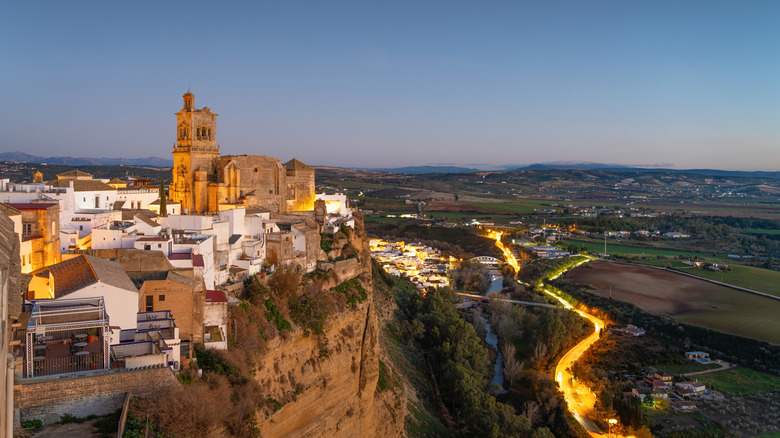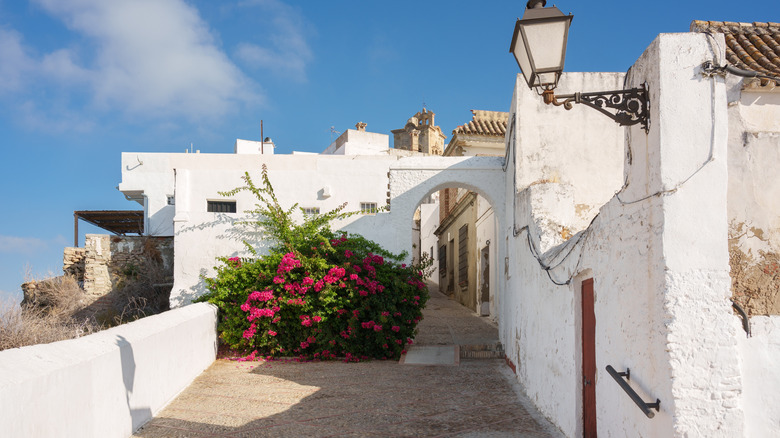One Of Rick Steves' Favorite Spots In Spain Is A Quaint Hill Town Off Most Tourists' Radar
As someone who lived in Spain for five years, I can say with utmost certainty that if you are the type of person who enjoys a travel destination where your day is jam-packed with activities, then a small village or town (although beautiful) will not be your cup of tea. These towns do, however, share a large sense of community, have a unique culture and history, and are typically some of the best places to get an authentic meal, just like abuela used to make. Although there are many of these highly underrated towns dotted throughout Spain, Rick Steves has one in particular that he classifies as one of his favorites.
Arcos de la Frontera, a white-washed town set alongside a limestone cliff about an hour south of Seville, is a place that, despite its small stature, packs a punch with its large personality. This small town captures the true essence of Andalucía: steep cobblestone alleys, blinding white houses trimmed in iron balconies, flower-filled patios, and a skyline brimming with medieval towers and church domes.
In his blog post, "Daily Dose of Europe: Arcos de la Frontera — Pickles, Nuns, and Donkeys in the Bell Tower", Steves recalls fond memories of his time spent in Arcos.He states that "Arcos smothers its hilltop, tumbling down all sides like the train of a wedding dress. The labyrinthine old center is a photographer's feast." But this isn't just a pretty town. Arcos carries a deep history that mirrors the complex story of Spain itself. First settled by Romans, shaped by centuries of Muslim rule, and later reconquered by Christian forces, the town reflects a rich mixture of cultures that's evident in its architecture, traditions, and daily life.
Wander through white-washed alleyways
As with most European towns, the culinary heartbeat of Acros lies within the halls of its market. Although it doesn't need to be yours, Steves makes this his first stop, and comes across women pushing banderillas (a type of skewer with savory pickled vegetables), and many different meat stalls. Steves recommends that the "word to know" while in Spain is jamón, or ham — a must try while sampling your way through any Spanish market.
Once you've finished sampling ham, make your way towards the old town, where you'll discover a narrow maze of alleyways, whitewashed walls, and stone archways. Next, mosey your way towards the top of the hill, where you'll find the town's historic heart: Plaza del Cabildo. This square has a surprising number of monuments, like the Basilica of Santa María de la Asunción, the Town Hall, the Ducal Castle, the Parador de Turismo, and the Convent of the Mercedarias Descalzas. Be sure not to miss a delightful sweet treat at the convent (like cookies or cupcakes), which you can purchase from one of the nuns by pressing the buzzer and letting them know what you'd like.
From here, Steves recommends heading towards the Mirador de la Peña Nueva, a viewpoint at the main square offering panoramic valley views, to see what the residents mean when they brag, "only they see the backs of birds as they fly." Next to the viewpoint is a luxury hotel that was once an old palace, the Parador — a great place to stop off for a coffee on its beautiful terrace. Make your way towards the Mayorazgo Palace, a gorgeous 17th-century building that now houses the Municipal Department of Culture and offers visitors the chance to explore its temporary and permanent exhibits, as well as its beautiful Andalusian Gardens.
Taste your way through Arcos de la Frontera
Arcos is situated in the province of Cádiz, a region renowned for its sherry wine and fino. While Jerez de la Frontera is the center of sherry production, local bodegas and wine bars in Arcos offer tastings in a more laid-back setting. Try Bodega Huerta de Albalá, located about a 15-minute drive from town, for a full tasting experience of Andalusian wines. For a taste of abuela's home cooking, try Taberna Jovenes Flamencos, a popular and authentic restaurant serving up an array of traditional Spanish dishes. Don't forget to stop off for churros and chocolate and a café con leche at one of the many local cafés for a delicious morning snack.
If you decide to spend more than just a day, the above-mentioned Parador de Arcos de la Frontera is the most popular lodging option in town. La Casa Grande is a charming boutique hotel with panoramic terraces and traditional Andalusian decor, and Hotel El Convento is a great mid-range hotel, perfectly located, with balconies overlooking the surrounding countryside.
Arcos is best accessed by car, especially if you plan to visit other nearby white-washed villages like Grazalema, Zahara de la Sierra, or Ronda. Note that driving in the old town is extremely difficult, and it's recommended to park in the lower town and walk. Buses do run from larger cities like Jerez de la Frontera, Cadiz, and Seville; however, they can be infrequent.


